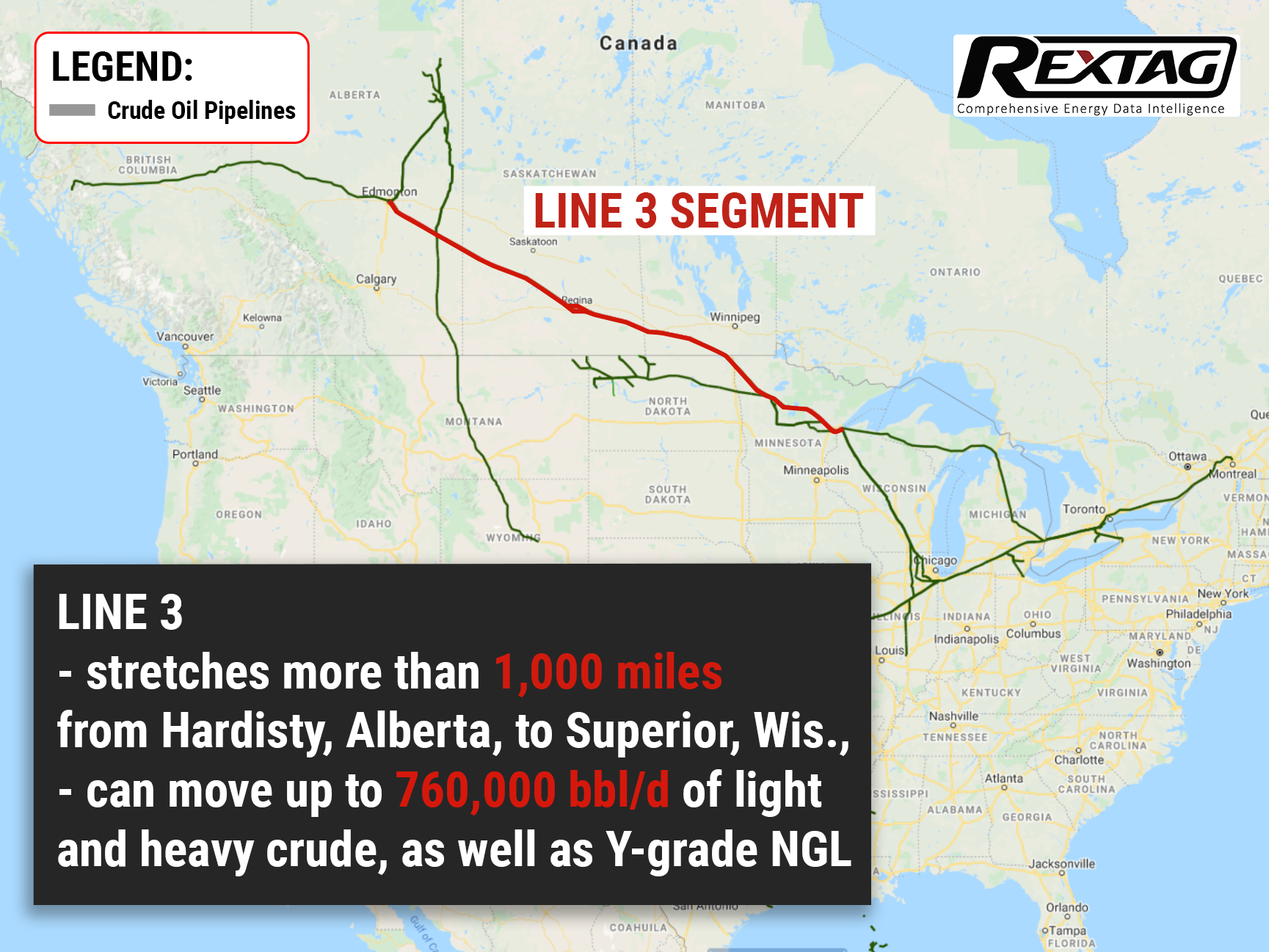Comprehensive Energy Data Intelligence
Information About Energy Companies, Their Assets, Market Deals, Industry Documents and More...
Delays Are Finally Over: Enbridge Reports Strong Third Quarter 2021
12/07/2021
Midstream companies had a stunning third quarter. Management teams' confidence in their business is evident in dividend increases and buyback activity. As 2022 approaches, this was the first quarter in two years that no midstream index members cut their dividends.
The completion of projects signals strength to investors, and pipeline giant Enbridge Inc. triumphantly completed several in the third quarter, which included the $4 billion Line 3 Replacement project. It consisted of replacing an existing 34-inch pipe with a new 36-inch one for 13 miles in North Dakota, 337 miles in Minnesota, and 14 miles in Wisconsin.
Enbridge's Line 3 pipeline has been and will remain an important component of its transportation network, delivering crude oil to refineries and to end-users. As a result of the replacement of Line 3, Enbridge will be able to transport crude oil to refineries in Minnesota and neighboring states, as well as in eastern Canada and the Gulf Coast.
It can move up to 760,000 barrels per day of light and heavy crude and NGL and sits more than 1,000 miles from Hardisty, Alberta, to Superior, Wis., which shifts some of the heavy crude load from Enbridge's Mainline system to Line 3.
Nevertheless, Line 3 was not the only major project completed by Enbridge during the third quarter. Its competitors were fierce as well.
For example, a total of $100 million was spent on the Appalachia to Market and Middlesex Extension gas projects. While as a result of the $500 million Southern Access expansion from Superior to Flanagan, capacity rose by 200 000 barrels per day to 1.2 MM barrels per day. On top of that, the company had upgraded compression and installed new natural gas pipelines to boost the capacity of the 1,776-mile BC pipeline system in northeast British Columbia to about 3.5 Bcf/d from 2.9 Bcf/d.
Moreover, September saw Enbridge purchase Moda Midstream LLC in a $3 billion cash deal. For the notice, the newly renamed facility, Enbridge Ingleside Energy Center, was accounted for 25% of U.S. crude oil exports in 2020. And the fourth quarter of the current year should see modest tailwinds from Moda as well.
As part of the purchase, the Viola Pipeline near Corpus Christi, Texas, and a 20% stake in the Cactus II Pipeline were included. It is expected that Enbridge will generate about $305 million in adjusted EBIDTA from the new assets by 2022.
The potential for exponential growth is also there. As the Permian supply recovers through 2024, despite the port's overbuilt capacity for crude oil exports, East Daley's Crude Hub Model predicts increased demand for crude oil exports through the port and the Ingleside terminal.
If you are looking for more information about energy companies, their assets, and energy deals, please, contact our sales office mapping@hartenergy.com, Tel. 619-349-4970 or SCHEDULE A DEMO to learn how Rextag can help you leverage energy data for your business.
The Final Stretch: Energy Transfer Pushes For Mariner East Project Ahead Of The Stunning Q3 Results
![$data['article']['post_image_alt']](https://images2.rextag.com/public/blog/Energy-Transfer-Pushes-For-Mariner-East-Project-Ahead-Of-The-Stunning-Q3-Results .png)
Energy Transfer's lead in the world's NGL exports booked the company another successive quarter. With a global market share of almost 20%, the company is nigh unstoppable. But will it be enough to, finally, push the Mariner East project over the edge? If everything goes as planned, Mariner East's last segment could be operational by the end of the first half of 2022.
Smart Investments Are The Key To Success: Williams JV Brought Benefits At The End Of The Year
![$data['article']['post_image_alt']](https://images2.rextag.com/public/blog/Williams-JV-Brought-Benefits-At-The-End-Of-The-Year.png)
Williams boasts its Q3 results. With a revenue of $2.48 billion, the company beat the analyst estimate of $2.09 billion and also improved upon its own results over the same period in 2020. Mind you, much of this success was attributed to production in Wyoming's Green River Basin's Wamsutter Field and Williams JV with Crowheart.
![$data['article']['post_image_alt']](https://images2.rextag.com/public/blog/328_Blog_Why Are Oil Giants Backing Away from Green Energy Exxon Mobil, BP, Shell and more .jpg)
As world leaders gather at the COP29 climate summit, a surprising trend is emerging: some of the biggest oil companies are scaling back their renewable energy efforts. Why? The answer is simple—profits. Fossil fuels deliver higher returns than renewables, reshaping priorities across the energy industry.
![$data['article']['post_image_alt']](https://images2.rextag.com/public/blog/327_Blog_Oil Market Outlook A Year of Growth but Slower Than Before.jpg)
The global oil market is full of potential but also fraught with challenges. Demand and production are climbing to impressive levels, yet prices remain surprisingly low. What’s driving these mixed signals, and what role does the U.S. play?
![$data['article']['post_image_alt']](https://images2.rextag.com/public/blog/326_Blog_USA Estimated Annual Rail CO2 Emissions 2035.jpg)
Shell overturned a landmark court order demanding it cut emissions by nearly half. Is this a victory for Big Oil or just a delay in the climate accountability movement?